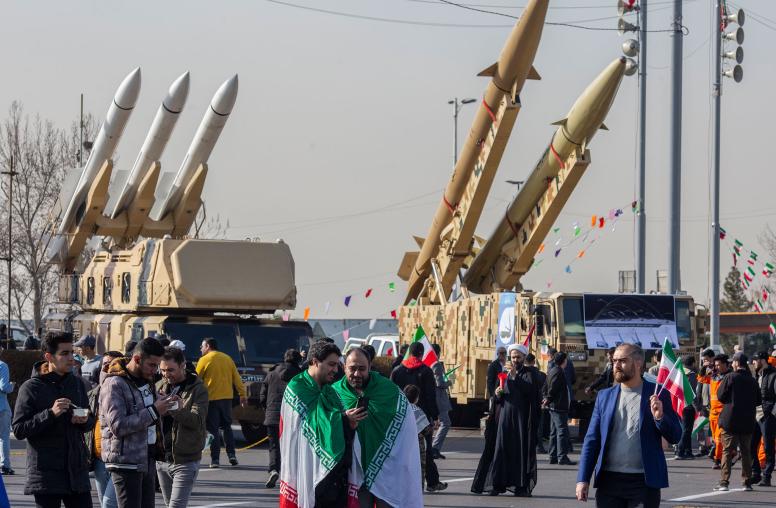Three Takeaways from the Strategic Posture Commission’s Report
Bipartisan panel warns about new threats from China and Russia.
In November, USIP hosted the heads of the Strategic Posture Commission (SPC), Chair Madelyn Creedon and Vice Chair Jon Kyl, to talk about their recent report on the future of the United States’ strategic posture.

Congress stood up the bipartisan SPC to look at the global threats, defense strategy and military capabilities affecting deterrence. With its sweeping mandate comes a substantial report containing dozens of conclusions. Three of them stand out.
Is One War Enough?
The last time Congress had a fresh look at U.S. strategic posture, the world looked a lot different. As USIP President Lise Grande noted in her introductory remarks, the 2009 SPC found that existential threats had decreased since the end of the Cold War; Russia was not an ally, but also not an enemy; and the risk of war with China was low, nuclear war even lower. That was then.
Now, the challenge of facing two nuclear-armed peers forms the bedrock of the SPC’s report. Specifically, the SPC warns about the threat of “opportunistic or collaborative” aggression from China and Russia in the next several years. This is a low-chance, high-cost scenario for defense planning. Critics say it encourages a kind of doomsday thinking and inflates the requirements of deterrence. By comparison, a recent study sponsored by the State Department argues that Russia and China “may never achieve a relationship that will require the United States to plan” for coordinated attacks by both. But downplaying this risk, the SPC would respond, could actually have the “perverse effect of making such aggression more likely.”
Against this hard test of combined aggression, the SPC judges that current defense planning will not “adequately address” the threat. The 2022 National Defense Strategy, like its 2018 predecessor, plans for the U.S. military to defeat a single great power while deterring a second. That was a step change from the post-Cold War standard of winning two medium-sized wars, like the Gulf War, at the same time. Preparing for one war, critics say, invites the risk of two. The SPC therefore calls for a two great-power war standard that “requires increases in the size, type, and posture of U.S. and allied conventional forces.”
When the U.S. military last prepared to fight two major wars, in the 1960s, the United States spent nearly twice as much on defense (as a percentage of GDP) and relied on nuclear escalation to win. Today, though, there is serious doubt about whether U.S. forces can defeat their pacing threat, China. Building a military to win two great-power wars would be the height of ambition.
What’s Behind China’s Buildup?
China’s nuclear buildup is the backdrop of the report, and the SPC has a view on what is driving it. This has been a subject of some debate.
To simplify, in one view, China is updating its deterrence requirements in reaction to new U.S. military capabilities and a downturn in U.S.-China relations. For years, Chinese officials have criticized U.S. intentions behind missile defense, long-range precision weapons and even arms control. That is on top of old suspicions about U.S. support for Taiwan, regional alliances and a perceived strategy of containing China’s rise. According to U.S. intelligence, “China is reorienting its nuclear posture for strategic rivalry with the United States because its leaders have concluded that their current capabilities are insufficient.” Indeed, some scholars see the United States and China as locked in a spiral, in which conventional and nuclear capabilities interact to create a security dilemma. That is dangerous because one side would see the other side’s defensive move as aggressive, leaving both sides less secure.
In another view, though, China’s nuclear buildup mostly reflects its revisionist ambitions. Based on Chinese sources, the Pentagon has assessed that China's military needs will increase as the “large country” becomes a “powerful country.” That includes the minimum nuclear deterrent to protect its growing interests. The SPC’s position comes closer to this view. Creedon said at USIP that, “there is clearly a desire on the part of China to play a different role in the world ... And it’s that new role of China being a power globally that I think is driving them.” The SPC report even claims that the speed of China’s nuclear expansion reflects an “increased role for military power in achieving their goals.”
If, on the one hand, China wants to preserve the status quo but reacts to perceived threats, then U.S. actions to improve deterrence would risk a dangerous arms race. If, on the other, China is not reacting to U.S. actions but realizing its own goals, then fear of an arms race is wrong, and arming is right. Responses to China’s buildup hinge on what is behind it.
Why the Nuclear Tomahawk?
While the SPC avoids making a force structure wish list, it comes close to naming one item. The SPC calls for a capability that is regional, survivable, limited, penetrating and prompt to deter an adversary’s limited nuclear use. As Kyl testified to the U.S. Senate Armed Services Committee on October 19, that describes the controversial nuclear-armed sea-launched cruise missile (SLCM-N) program.
The 2018 Nuclear Posture Review (NPR) pointed to the need to deter Russia’s limited nuclear use under the legal constraints of the (now-defunct) Intermediate-Range Nuclear Forces (INF) treaty. It started the SLCM-N program as one of two capabilities to supplement the nuclear modernization program of record. The 2022 NPR canceled SLCM-N but — without a budget request — Congress gave the program limited funding.
Supporters of SLCM-N also argue that it can shore up regional deterrence in Asia, where it could deploy at sea without the permission of a host nation. Those supporters worry that China may be capable of a limited nuclear attack to coerce the United States to back down in a fight. SLCM-N would provide another limited option to respond with. Opponents, however, note that deploying SLCM-N would come at the price of conventional capacity. They argue that SLCM-N would do little to lower risk because it does not fix the military balance in the Western Pacific.
This year’s annual defense policy bill makes the SPC’s wish a reality. As U.S. Rep. Doug Lamborn (R-CO), who leads the House Armed Services Committee’s Subcommittee on Strategic Forces, said in his USIP keynote address: “We cannot afford to be placed in a position where an adversary conducts a limited strike, and our only option is surrender or massive retaliation. All or nothing may not be the best response.”
Atoms and Numbers
The SPC does leave a trillion-dollar question unanswered. Its consensus report offers only that the United States needs a nuclear force “either larger in size, different in composition, or both.” Most experts agree that the United States need not match Russia and China’s total arsenals, yet many think some buildup is needed. Like during the Cold War, the United States will have to figure out how much is enough.
And, while finding the right number of nuclear weapons, the United States cannot ignore another figure. The SPC did not estimate the cost of its recommendations. As Kyl put it, the United States can afford to prevent nuclear war. The SPC calls on political leaders to make the case for it. Yet that is ambitious, as defense spending has fallen short of its target for several years. Also like the Cold War, then, the United States will have to remember that strategy wears a dollar sign.



